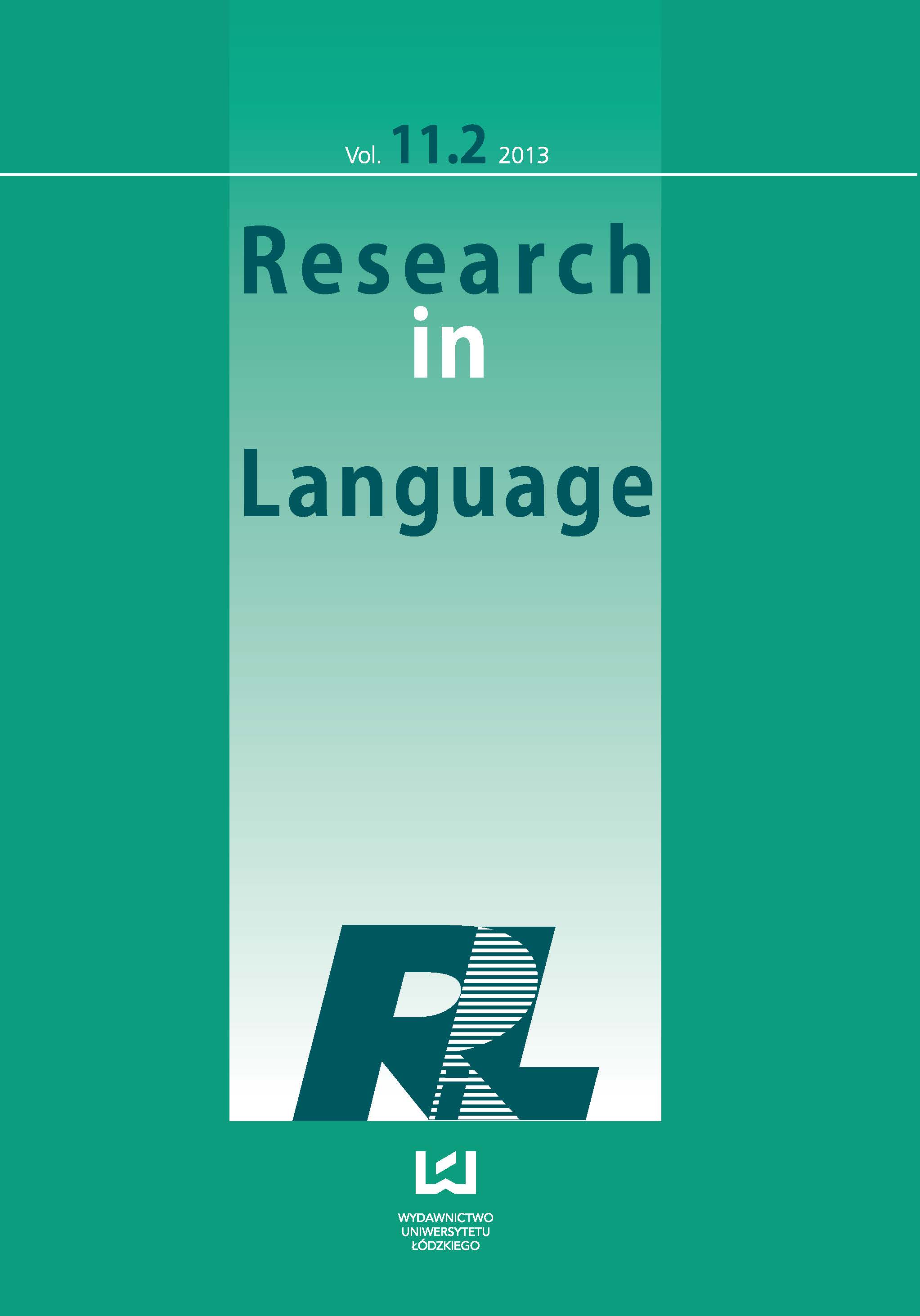Discourse-Driven Meaning Construction in Neosemantic Noun-to-Verb Conversions [Meaning Construction In Noun-To-Verb Conversions]
DOI:
https://doi.org/10.2478/v10015-012-0026-4Keywords:
conversion, cognitive linguistic, conceptual integration, discourse spaceAbstract
Neosemantic noun-to-verb conversions such as beer → to beer, door → to door, pink → to pink, etc., constitute a particularly interesting field of study for Cognitive Linguistics in that they call for a discourse-guided and context-based analysis of meaning construction. The present article takes a closer look at the cognitive motivation for the conversion process involved in the noun-verb alterations with a view to explaining the semantics of some conversion formations in relation to the user-centred discourse context. The analysis developed in this article draws from the combined insights of Fauconnier and Turner’s (2002) Conceptual Integration Theory and Langacker’s (2005, 2008) Current Discourse Space.
References
Clark, Eve V. & Herbert H. Clark (1979). “When nouns surface as verbs”. Language, 55, 767-811.
Google Scholar
Clark, Herbert H. (1996). Using Language. Cambridge: Cambridge University Press.
Google Scholar
Coulson, Seana (2001). Semantic Leaps. Frame-shifting and Conceptual Blending in Meaning Construction. Cambridge, New York, Melbourne, Madrid, Cape Town, Singapore, Sao Paulo: Cambridge University Press.
Google Scholar
Croft, William & Alan D. Cruse (2004). Cognitive Linguistics. Cambridge: Cambridge University Press.
Google Scholar
Dirven, René & Marjolijn Verspoor (2004). Cognitive Exploration of Language and Linguistics. Amsterdam, Philadelphia: John Benjamins Publishing Company.
Google Scholar
Elsen, Hilke (2004). Neologismen. Formen und Funktionen neuer Wörter in verschiedenen Varietäten des Deutschen. Tübingen: Gunter Narr Verlag.
Google Scholar
Evans, Vyvyan and Melanie Green (2006). Cognitive Linguistics: An Introduction. Edinburgh: Edinburgh University Press.
Google Scholar
Fauconnier Gilles (1985). Mental Spaces. Cambridge, Mass.: MIT Press.
Google Scholar
Fauconnier, Gilles (1994). Mental Spaces: Aspects of Meaning Construction in Natural Language. Cambridge: Cambridge University Press.
Google Scholar
Fauconnier, Gilles (1997). Mappings in Thought and Language. Cambridge: Cambridge University Press.
Google Scholar
Fauconnier, Gilles & Mark Turner (1994). “Conceptual Projection and Middle Spaces”. San Diego: University of California, Department of Cognitive Science Technical Report 9401. Retrieved March 15, 2010, from http://markturner.org
Google Scholar
Fauconnier, Gilles & Mark Turner (1998). “Principles of Conceptual Integration”. In J.- P. Koenig (Ed.), Discourse and Cognition (269-283). Stanford: Center for the Study of Language and Information.
Google Scholar
Fauconnier, Gilles & Mark Turner (2002). The Way We Think. Conceptual Blending and the Mind’s Hidden Complexities. New York: Basic Books.
Google Scholar
Fauconnier, Gilles & Mark Turner (2007). Conceptual integration networks. In V. Evans, B. K. Bergen & J. Zinken (Eds.), The Cognitive Linguistic Reader (360-419). London, Oakville: Equinox Publishing Ltd.
Google Scholar
Grabias, Stanisław (1980). O ekspresywności języka. Ekspresja a słowotwórstwo. Lublin: UMCS.
Google Scholar
Gumperz, John J. (1992). “Contextualization and understanding”. In Ch. Goodwin & A. Duranti (Eds.), Rethinking Context: Language as an Interactive Phenomenon (229- 252). Cambridge: Cambridge University Press.
Google Scholar
Herberg, Dieter & Michael Kinne (1998). Neologismen. Heidelberg: Groos.
Google Scholar
Kardela, Henryk (2006). “(Nie)podobieństwa w morfologii: amalgamaty kognitywne”. In H. Kardela, Z. Muszyński & M. Rajewski (Eds.), Kognitywistyka: Podobieństwo (195-210). Lublin: Wydawnictwo UMCS.
Google Scholar
Kardela, Henryk (2007). “‘Good’ revisited: A mental space analysis”. In U. Magnusson, H. Kardela & A. Głaz (Eds.), Further Insights into Semantics and Lexicography (291-303). Lublin: Wydawnictwo UMCS.
Google Scholar
Kemmer, Suzanne (2003). “Schemas and lexical blends”. In G. Radden & H. Cuyckens (Eds.), Motivation in Language. Studies in Honor of Günter Radden (69-95). Amsterdam, Philadelphia: John Benjamins.
Google Scholar
Langacker, Ronald W. (1987). Foundations of Cognitive Grammar, vol. 1: Theoretical Prerequisites. Stanford: Stanford University Press
Google Scholar
Langacker, Ronald W. (1991). Concept, Image, and Symbol: The Cognitive Basis of Grammar. Berlin: Mouton de Gruyter
Google Scholar
Langacker, Ronald W. (1999). Grammar and Conceptualization. Berlin, New York: Mouton de Gruyter.
Google Scholar
Langacker, Ronald W. (2005). Wykłady z gramatyki kognitywnej. Lublin: Wydawnictwo UMCS
Google Scholar
Langacker, Ronald W. (2008). Cognitive Grammar. A Basic Introduction. New York: Oxford University Press
Google Scholar
Langlotz, Andreas (2006). Idiomatic Creativity. A cognitive-linguistic model of idiomrepresentation and idiom-variation in English. Amsterdam, Philadelphia: John Benjamins Publishing Company.
Google Scholar
Libura, Agnieszka (2007). Amalgamaty kognitywne w sztuce. Kraków: Universitas.
Google Scholar
Lieber, Rochelle (2004). Morphology and Lexical Semantics. Cambridge: Cambridge University Press.
Google Scholar
Roberts, Craige (2004). “Context in dynamic interpretation”. In L. R. Horn & G. Ward (Eds.), The handbook of pragmatics (197-220). Oxford: Blackwell Publishing.
Google Scholar
Taylor, John R. (2002). Cognitive Grammar. Oxford: Oxford University Press.
Google Scholar
Taylor, John R. (2003). Linguistic Categorization: Prototypes in Linguistic Theory, 3rd ed. Oxford: Oxford University Press.
Google Scholar
Twardzisz, Piotr (1997). Zero Derivation in English: A Cognitive Grammar Approach. Lublin: Wydawnictwo UMCS.
Google Scholar
Veale, Tony & Cristina Butnariu (2010). Harvesting and understanding of on-line neologisms. In A. Onysko & S. Michel (Eds.), Cognitive Perspectives on Word Formation (399-420). Berlin, New York: Mouton de Gruyter.
Google Scholar
The Rice University Neologisms Database. Retrieved February 10, 2011, from http://neologisms.rice.edu/index.php
Google Scholar
Urban Dictionary. Retrieved February 10, 2011, from http://www.urbandictionary.com/
Google Scholar
Downloads
Published
How to Cite
Issue
Section
License

This work is licensed under a Creative Commons Attribution-NonCommercial-NoDerivatives 4.0 International License.










